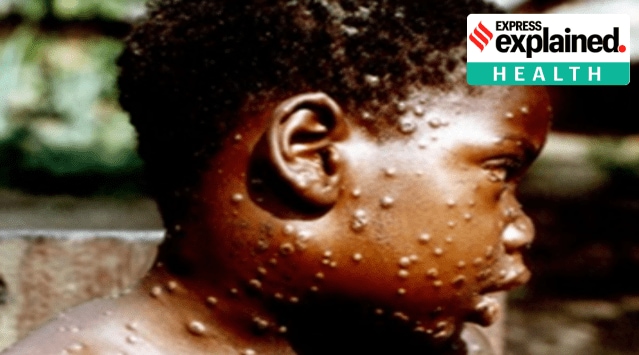- India
- International
Explained: What is monkeypox, a smallpox-like disease from Africa that has been reported in the UK?
Health authorities in the United Kingdom have confirmed a case of monkeypox, a rare viral infection similar to smallpox, in an individual who recently travelled to that country from Nigeria.
 Monkeypox is a zoonosis, that is, a disease that is transmitted from infected animals to humans. (Photo credit: WHO)
Monkeypox is a zoonosis, that is, a disease that is transmitted from infected animals to humans. (Photo credit: WHO)
Health authorities in the United Kingdom have confirmed a case of monkeypox, a rare viral infection similar to smallpox, in an individual who recently travelled to that country from Nigeria.
What is Monkeypox virus?
The monkeypox virus is an orthopoxvirus, which is a genus of viruses that also includes the variola virus, which causes smallpox, and vaccinia virus, which was used in the smallpox vaccine. Monkeypox causes symptoms similar to smallpox, although they are less severe.
While vaccination eradicated smallpox worldwide in 1980, monkeypox continues to occur in a swathe of countries in Central and West Africa, and has on occasion showed up elsewhere. According to the World Health Organisation (WHO), two distinct clade are identified: the West African clade and the Congo Basin clade, also known as the Central African clade.
Zoonotic disease
Monkeypox is a zoonosis, that is, a disease that is transmitted from infected animals to humans. According to the WHO, cases occur close to tropical rainforests inhabited by animals that carry the virus. Monkeypox virus infection has been detected in squirrels, Gambian poached rats, dormice, and some species of monkeys.
Human-to-human transmission is, however, limited — the longest documented chain of transmission is six generations, meaning the last person to be infected in this chain was six links away from the original sick person, the WHO says. “It is important to emphasise that monkeypox does not spread easily between people and the overall risk to the general public is very low,” Dr Colin Brown, Director of Clinical and Emerging Infections at the UK Health Security Agency (UKHSA) said on Saturday.

Transmission, when it occurs, can be through contact with bodily fluids, lesions on the skin or on internal mucosal surfaces, such as in the mouth or throat, respiratory droplets and contaminated objects, the WHO says.
 Monkeypox causes symptoms similar to smallpox, although they are less severe. (Photo credit: WHO)
Monkeypox causes symptoms similar to smallpox, although they are less severe. (Photo credit: WHO)
Monkeypox disease: Symptoms and treatment
According to the US Centers for Disease Control and Prevention (CDC), monkeypox begins with a fever, headache, muscle aches, back ache, and exhaustion. It also causes the lymph nodes to swell (lymphadenopathy), which smallpox does not. The WHO underlines that it is important to not confuse monkeypox with chickenpox, measles, bacterial skin infections, scabies, syphilis and medication-associated allergies.
The incubation period (time from infection to symptoms) for monkeypox is usually 7-14 days but can range from 5-21 days. Usually within a day to 3 days of the onset of fever, the patient develops a rash that begins on the face and spreads to other parts of the body. The skin eruption stage can last between 2 and 4 weeks, during which the lesions harden and become painful, fill up first with a clear fluid and then pus, and then develop scabs or crusts.
According to the WHO, the proportion of patients who die has varied between 0 and 11% in documented cases, and has been higher among young children.
There is no safe, proven treatment for monkeypox yet. The WHO recommends supportive treatment depending on the symptoms. Awareness is important for prevention and control of the infection.
Occurrence of disease
The CDC’s monkeypox overview says the infection was first discovered in 1958 following two outbreaks of a pox-like disease in colonies of monkeys kept for research — which led to the name ‘monkeypox’.
The first human case was recorded in 1970 in the Democratic Republic of the Congo (DRC) during a period of intensified effort to eliminate smallpox.
According to the WHO, 15 countries on four continents have so far reported confirmed cases of monkeypox in humans.
Newsletter | Click to get the day’s best explainers in your inbox
Locally acquired cases have been confirmed in the DRC (which has the largest incidence of the infection in the world), Central African Republic, Republic of the Congo, Gabon, Cameroon, Nigeria, Côte d’Ivoire, Liberia, and Sierra Leone.
Imported cases have been found in South Sudan and Benin in Africa, and in the United States, UK, Israel, and Singapore.
More Explained
EXPRESS OPINION
May 04: Latest News
- 01
- 02
- 03
- 04
- 05







































